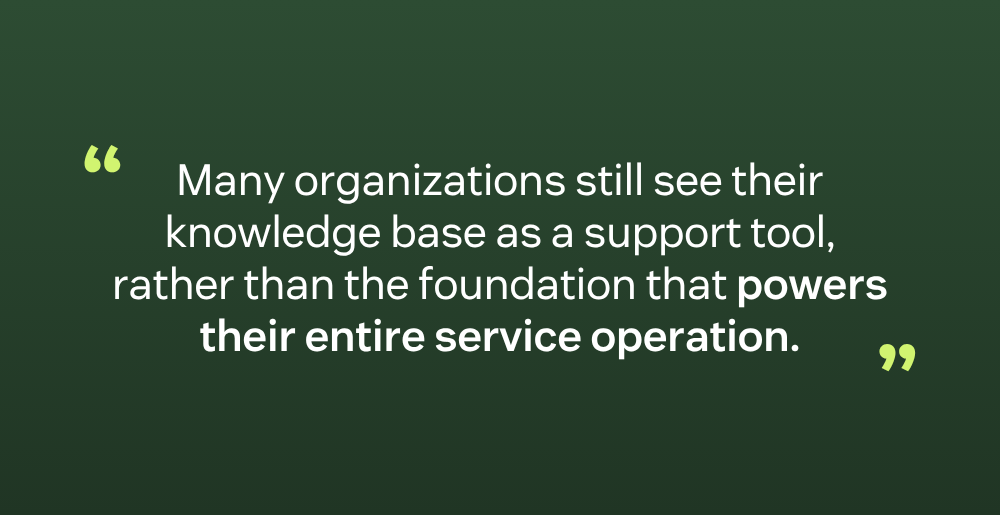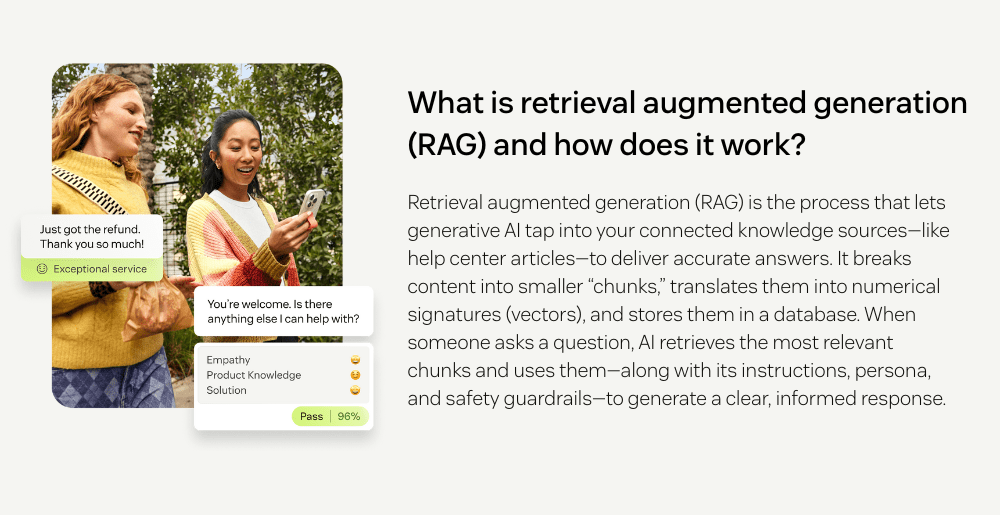Article • 5 min read
Knowledge has evolved: 4 tips to help service leaders catch up
Why the success of your AI—and your customer or employee service organization—depends on a unified knowledge foundation.
Ryan McGrew
Vice President of Product - AI Agents, Self-service, Knowledge Management at Zendesk
최종 업데이트: October 14, 2025
Knowledge guides every service interaction—whether it’s a customer returning an item, an AI agent escalating an issue, or an employee self-servicing an IT issue. Yet many organizations still see their knowledge base as a support tool, rather than the foundation that powers their entire service operation.
AI can only ever be as strong as the knowledge it draws from. If that information is outdated, fragmented, or inaccessible, even the most advanced AI will deliver inconsistent results. And when that happens, it directly impacts customer trust, employee productivity, and your ability to deliver great service.

I frequently hear from service leaders that this feels like a heavy lift—that they don’t have the resources to properly build and manage a knowledge base. And many cite it as a major reason why they’re still hesitant to move forward with AI. But the truth is that most already have the knowledge they need, it’s just scattered across emails, policy docs, shared drives, or in the minds of experienced agents. The real challenge is connecting it and making it usable.
Here’s the good news: while AI may depend on knowledge to work well, it also happens to be the tool that can bring it together. It pulls from sources across your organization to index and surface it in seconds, creating a single source of truth that keeps your service operation accurate, efficient, and able to meet the needs of modern customers and employees alike.
How knowledge has evolved in service today
Knowledge no longer lives in a help center alone. AI has changed how information moves through an organization and how it’s used. It can now connect to virtually any source—emails, PDFs, presentations, Slack channels, Google drives—to deliver fast, accurate information where it’s needed.
That shift has fundamentally changed what knowledge is and how it’s applied. In the past, looking for a specific return policy might have meant scanning multiple articles or pinging a colleague. Now, using retrieval augmented generation (RAG), AI can discover and pull all relevant information into a single, personalized response.
The result is far more accurate and effective service. By connecting their knowledge base to an AI agent, Dorm Room Movers now resolves 52% of all incoming tickets automatically—delivering instant, personalized answers instead of making customers search for them.

Why having a unified knowledge base is so important
When knowledge is fragmented or missing, it creates gaps that slow down agents, frustrate customers, limit employee productivity, and prevent AI from delivering the speed and accuracy it’s built for.
Here are a few risks that come from not having a unified knowledge base:
- AI that guesses instead of knows: When AI isn’t grounded in accurate knowledge, it can produce misleading answers or fill in the blanks with guesswork. If this happens, it can undermine trust or even create legal risk.
- Inconsistent results: Fragmented knowledge makes it difficult to keep everyone aligned. You end up with conflicting or contradictory information across channels or missing updates on new policies, procedures, or emerging issues.
- Poor self-service experiences: Customers and employees want to solve problems on their own, but they’ll give up quickly if answers are hard to find or out of date.
Left unchecked, these risks add up—driving higher costs, lower satisfaction, and a service operation that can’t deliver on its AI potential. But addressed head-on and knowledge can instead become a key differentiator that deepens loyalty and powers sustainable business growth.
Building the right knowledge foundation: 4 tips for leaders
It’s time to think of knowledge not as a passive library, but as the engine that drives modern, AI powered service—one that’s dynamic, connected, contextual, and scalable. Here are four practical ways to turn your scattered knowledge into a living resource that drives value for your customers and employees alike:
1. Unify and connect your knowledge sources—and use them to ground your AI
A single platform for managing company knowledge ensures that everyone has access to the same updated, accurate information whenever they need it. It also provides AI with the context needed to deliver reliable answers every time.
By opting for a platform like Zendesk that’s equipped with a powerful RAG engine, out of the box connectors, and web crawling capabilities, the heavy lift of unifying knowledge content is done for you—ensuring every touchpoint is grounded in authoritative content, that’s kept fresh and up to date.
2. Let AI scale content creation and curation
Human agents and knowledge admins shouldn’t have to build content from scratch. AI can analyze tickets to identify common questions and transform quick notes or workarounds into clear, polished articles in minutes.
And if you’re starting from scratch, tools like Knowledge Builder can take it even further by using your ticket data and business context to automatically generate a comprehensive help center.
3. Make knowledge work for both humans and AI
Today’s knowledge bases are for people to read, but they’re also for AI to use. To make it work for everyone, content must be clear, structured, and consistent. Be sure your titles are formatted to match customer questions, break information into short, digestible sections, and avoid producing duplicate or conflicting articles.
4. Start with high-volume requests, then scale up
Start by automating your most repetitive questions to see how your knowledge performs. This gives your AI a reliable foundation to learn from and builds confidence across the team. As quality and performance improve, expand to more complex use cases and channels.
SeatGeek offers a strong example of what’s possible. The company powers its AI agents with a structured, context-rich knowledge base that delivers accurate, personalized answers instantly. Using Zendesk’s zero-training AI model, SeatGeek resolves issues quickly without complex setup, improving both customer satisfaction and support efficiency.
Knowledge that drives resolutions
Content sitting idly in a knowledge base doesn’t empower agents. It doesn’t help customers and it certainly won’t equip AI to deliver accurate answers. To drive real value, knowledge needs to be connected across sources, continuously updated, and ready to surface the moment it’s needed. Otherwise, it works against you: creating unnecessary friction for customers, agents, and your wider AI strategy.
It’s time to recognize knowledge as the strategic asset it is—no longer a burden to maintain and ready to power the next generation of service.
